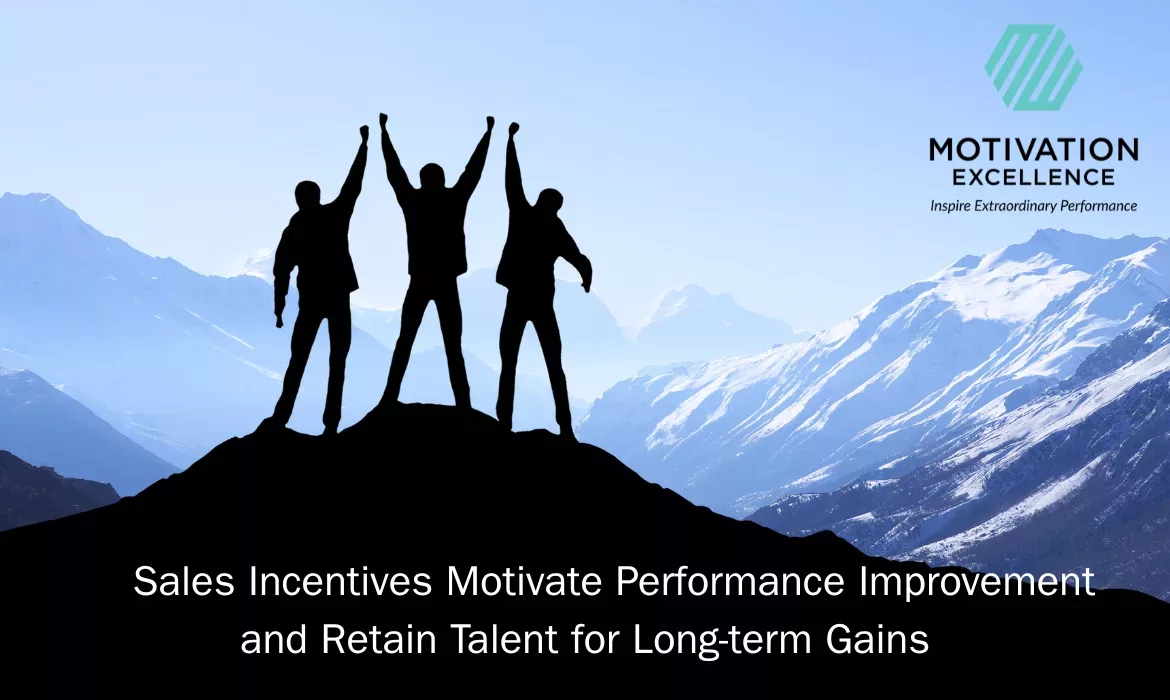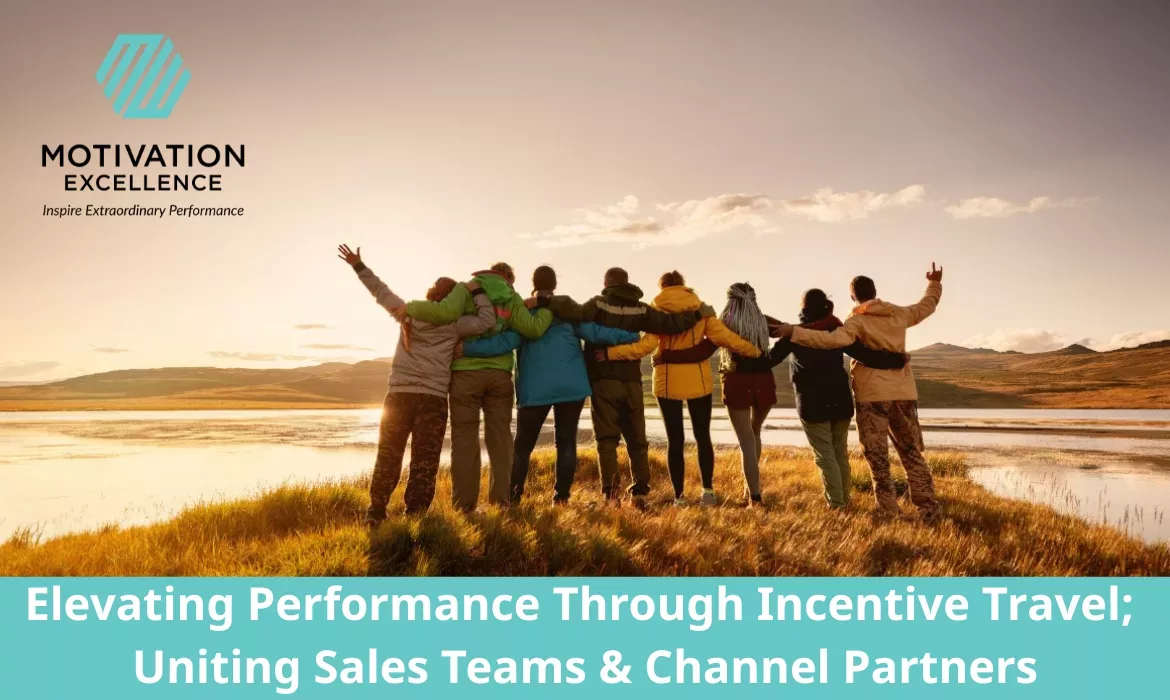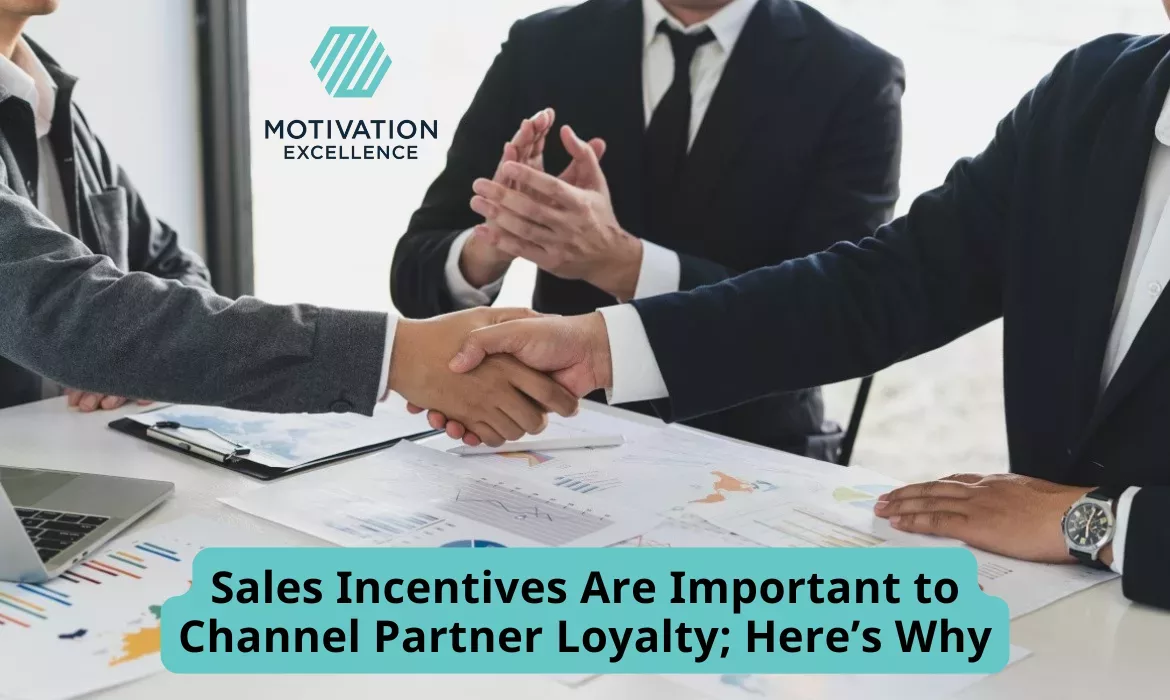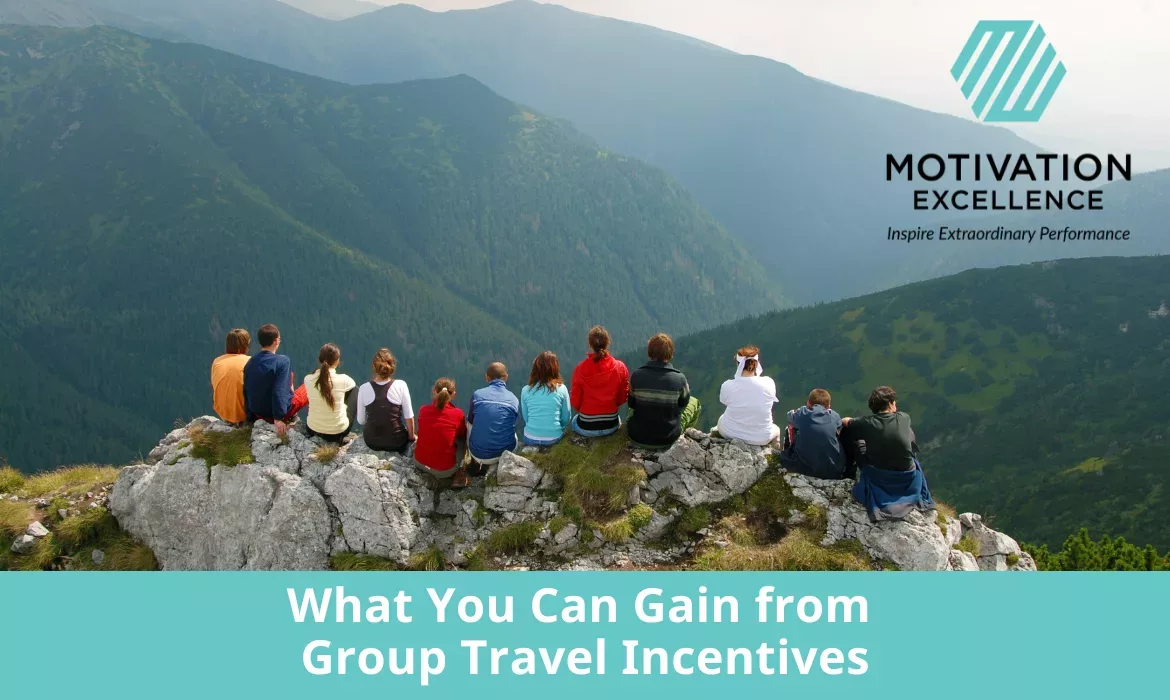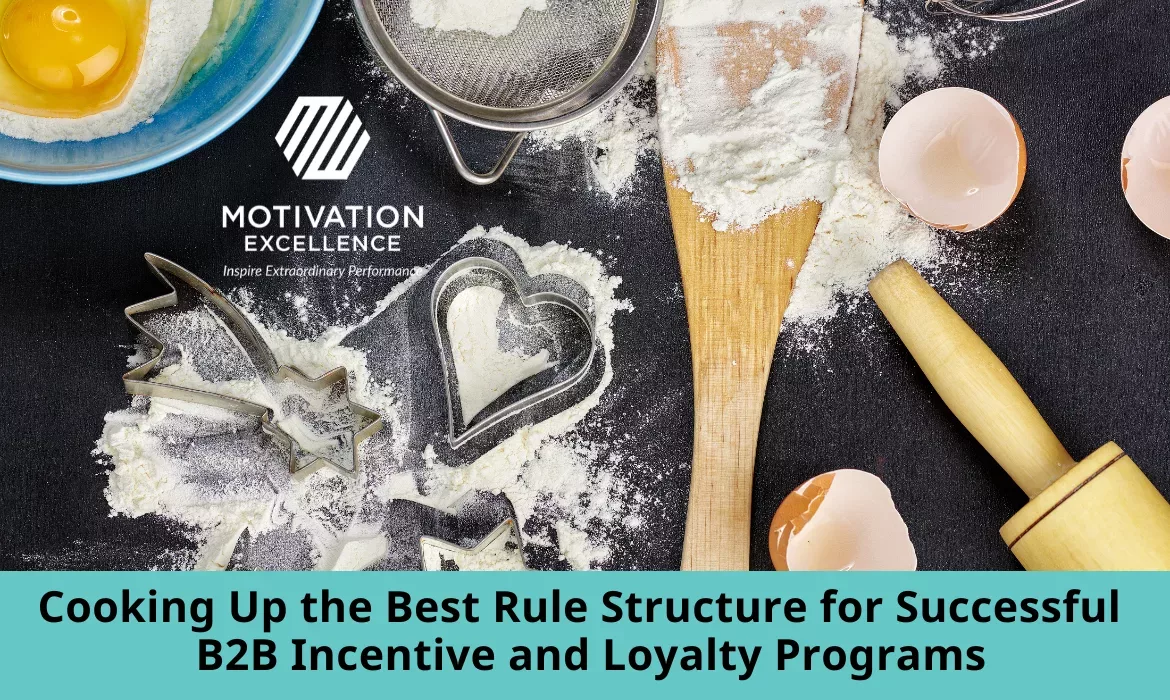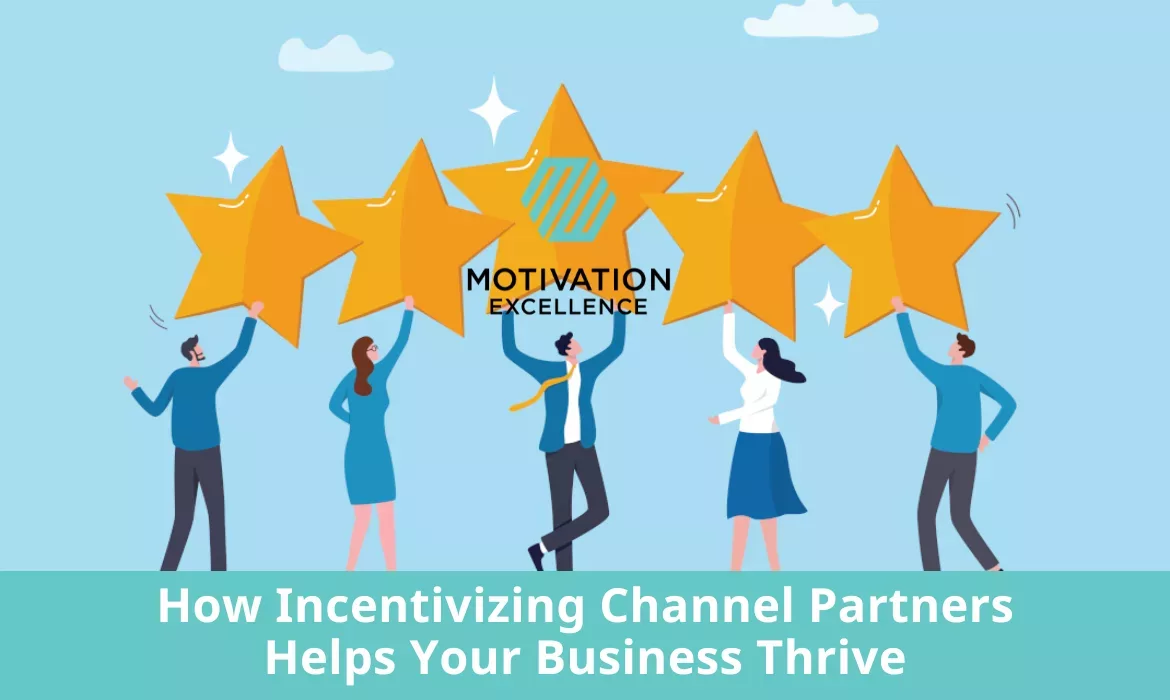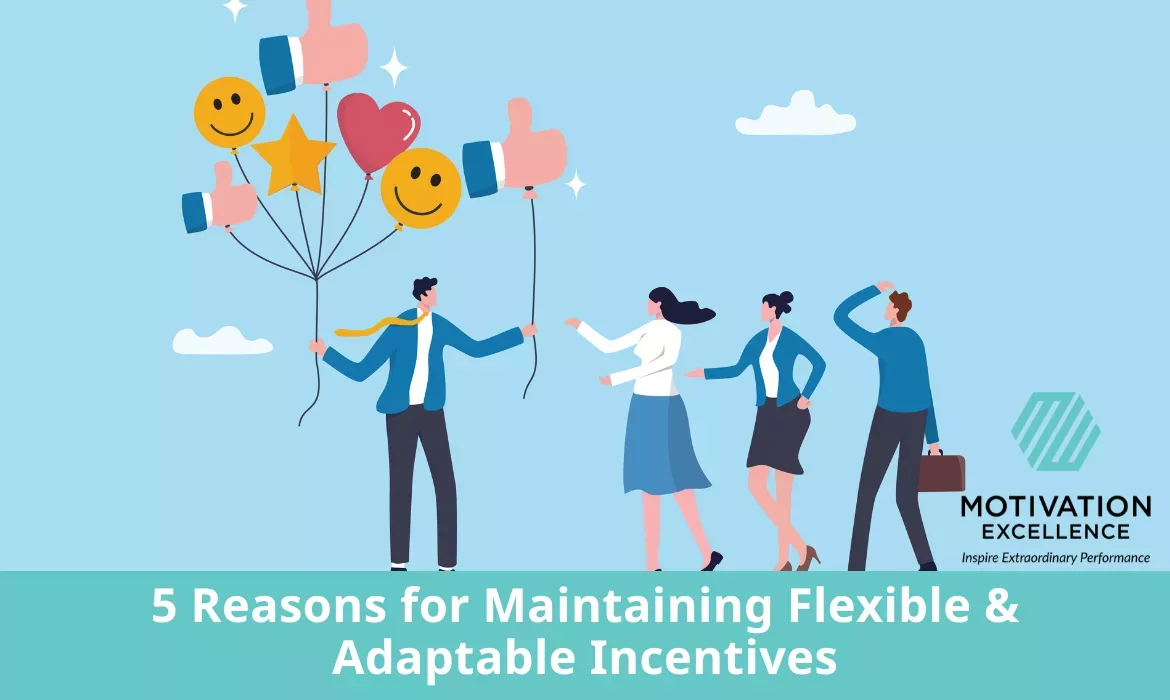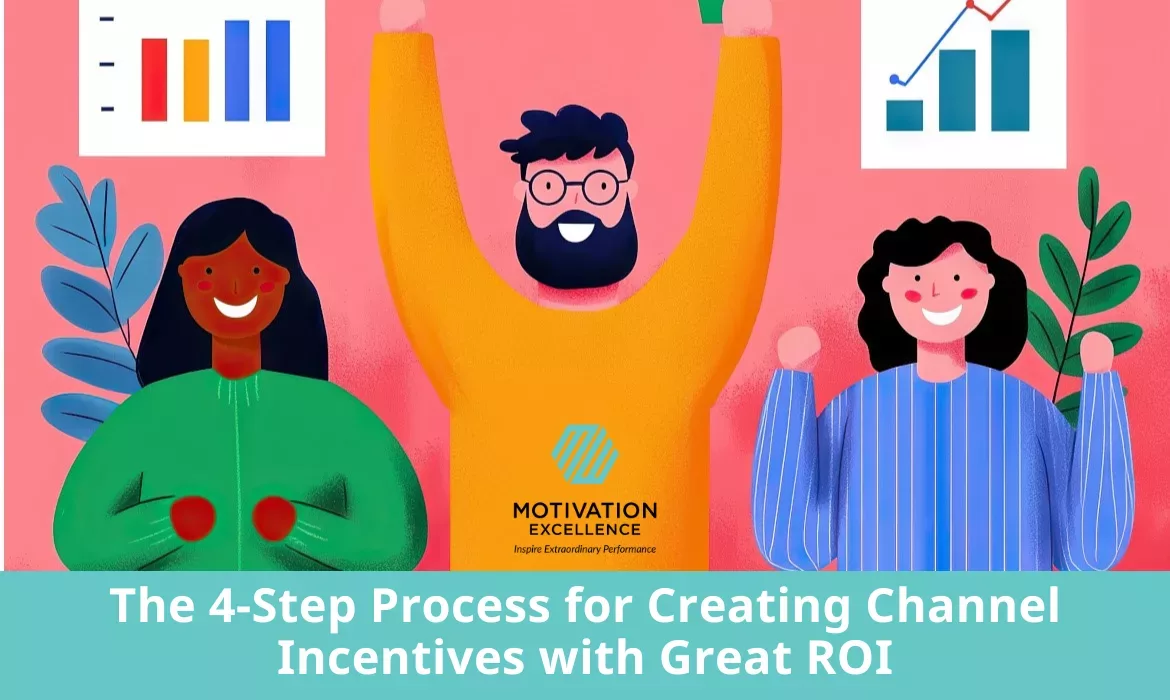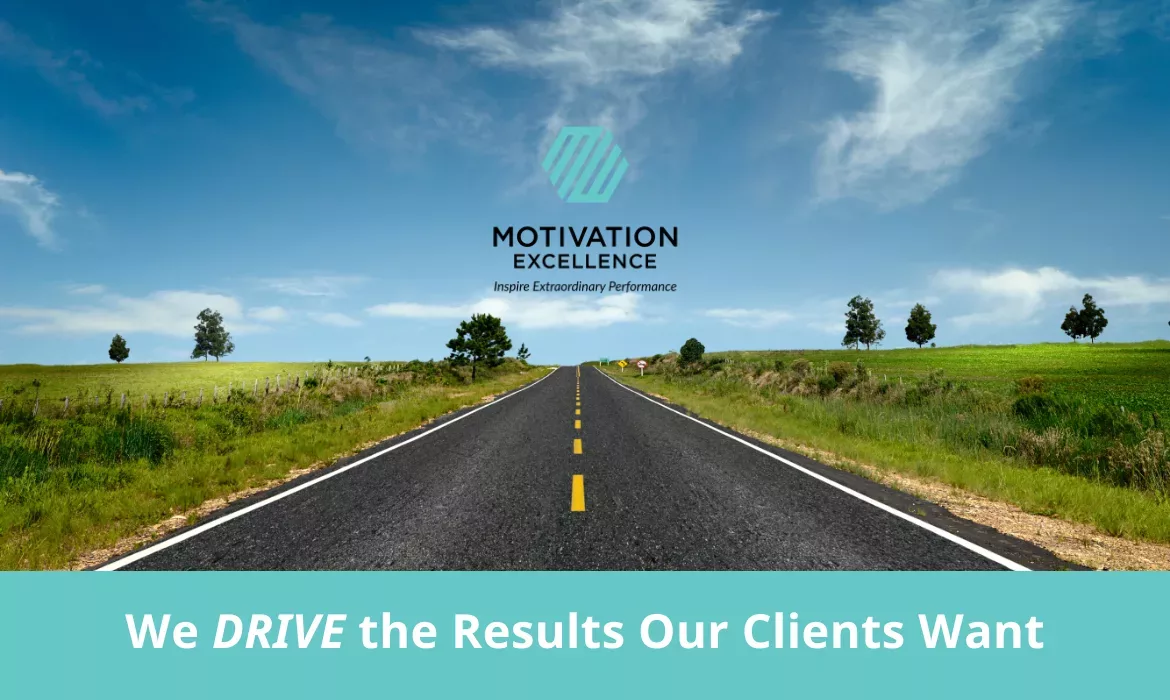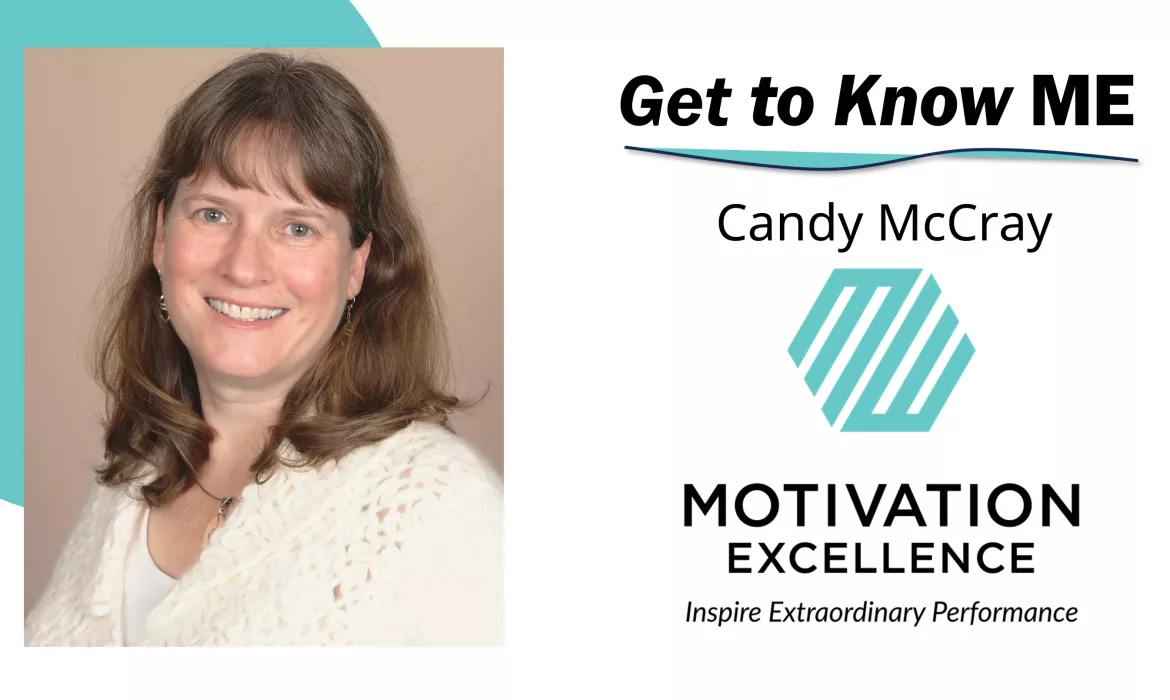Sales Incentives Motivate Performance Improvement and Retain Talent for Long-term Gains
Blog Summary:
· Sales incentives drive measurable performance improvements by motivating your sales team at all levels—especially the middle 60%, which can yield significant revenue increases with even small gains.
· Flexible and well-designed incentive programs align with business goals—everything ranging from short-term boosts to long-term engagement can inspire both individual and team achievements.
· Incentives support sales team member retention and loyalty by adding value to compensation packages, enhancing employee recognition, and fostering a culture of appreciation and motivation.
· When structured correctly, incentives can pay for themselves through incremental revenue gains, compliance, and best practice adoption, especially when rewards are meaningful and tailored to the sales team’s preferences.
Sales Incentives Offer Many Benefits
Getting incentives for outperforming your peers is instilled in us at an early age. Whether it was selling the most Girl Scout cookies for your troop or the most wrapping paper at your elementary school, taking a run at being the top contender definitely could have predestined you to a life in sales as an adult. But, if the reward for being the best wasn’t very good, the motivation to get to the top fell flat too, right?
Running well-designed sales incentive programs at your company can bring in a variety of benefits for both your business and your sales team. You can plan short-term and long-term programs. You can target segments of your sales team to motivate unique behavior changes at different levels.
Rewards for achieving goals can range from exclusive group travel experiences to points that can be redeemed online for almost anything, including individual travel, lifestyle upgrades, trending merchandise, and special event tickets. You can also reward in tiers, so those who bring in more business get rewarded at a level equal to their effort.
Our experts at Motivation Excellence know how to create sales incentive programs that Inspire Extraordinary Performance and can pay for themselves, plus deliver great long-term gains.
Improve Performance
Improving performance is the number one reason our clients run sales incentive programs. Sales incentives have a proven record of boosting performance and can be effectively used to motivate your entire sales force. The Incentive Research Foundation shows how even a small gain from the middle 60% of your team can yield significantly more revenue than the same shift in your top-performing group.
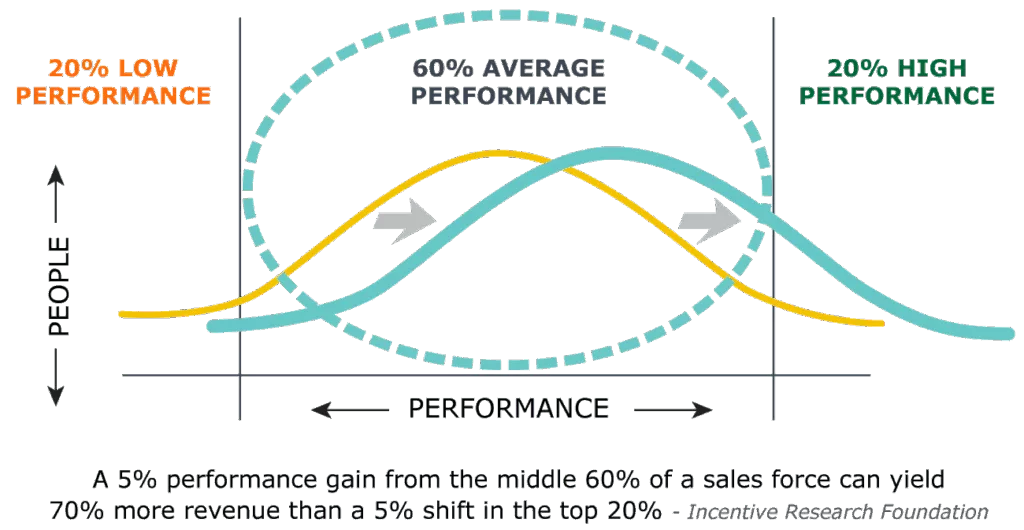
That’s why employing a targeted incentive plan can be a lucrative deal for everyone involved. Your best performers can vie for the top reward, but anyone making improvements gets something. This can encourage healthy competition within your sales team while also motivating achievements on a personal level. When performance gets better, so do the reward opportunities!
Incentives can be very flexible. You can run year-over-year incentives, or schedule them for shorter time periods if it makes sense for your sales cycle. Encouraging sales of a specific item, either because it’s brand new or yields a better margin, can lead to quick gains. The built-in excitement over a limited-time incentive helps drive momentum. Engaging in longer term sales incentives allows team members to plan ahead and perhaps drive in bigger gains. They’re also a great opportunity to track valuable metrics that can be useful for end-of-year review periods.
Whether they’re short- or long-term, sales incentives can keep your team engaged and motivated to perform at a higher level than they did in the period prior.
Retain Talent
There are quite a few things that add to the desirability of working somewhere. Obviously base salary, vacation time, and health insurance are at the top of the list for many! Offering additional benefits like a flexible work environment and education reimbursement can be very appealing as well. Recognizing milestones and special achievements, along with offering incentives for your sales team, helps build a culture where people can see themselves thriving for years.
We advise our clients that retaining top talent, and thus, increasing profits over the long haul, takes three distinct compensation elements: salary, recognition and incentives. They each have a role to play. Combined, they offer stability, acknowledgment, and engagement.
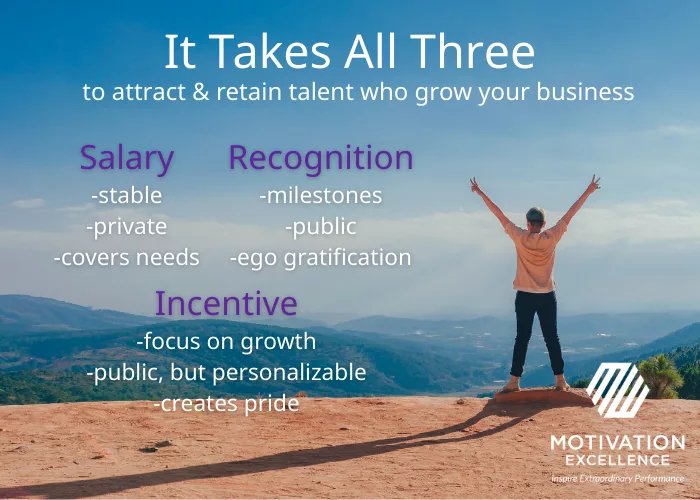
For the recognition and incentive elements, the rewards are key to making these worth the extra effort. They need to have value to your salesperson. If they don’t, they won’t offer anything to an overall benefits package. If they do, you’ve created additional ways to make your team feel valued.
Incentives Can Pay for Themselves
The right rule structure is imperative from the start of any incentive. When we know our clients’ goals, target audience, and some simple sales data, we can build an incentive that pays for itself – and then some – just with incremental gains.
Determining the desired rewards and their cost allows us to back into the performance expectations required to earn them. Selecting motivating rewards, like a group travel experience with company executives to Thailand… or the ability to earn once-in-a-lifetime tickets to a big sporting event… or the option to rent a vacation home for the family, is the lynchpin for the incentive to be successful.
Sales incentives can certainly be a fun, creative, and flexible way to motivate improved performance. This blog focuses on internal sales teams, but everything we’ve written is true for channel partner incentives, too. If you’re interested in reading more about the benefits of channel partner incentives, please check out these recent blogs:
How Incentivizing Channel Partners Helps Your Business Thrive
Channel Partner Engagement: Common Challenges and Overcoming Them
The 4-Step Process for Measuring Channel Incentive ROI
Explore our website and reach out to us if you’d like to consult about how best to run a successful incentive for your company!
Elevating Performance Through Incentive Travel: Uniting Sales Teams and Channel Partners
Motivation Excellence, experts in incentive travel, explains how to elevate sales teams and channel partners through incentive travel.
Sales Incentives Are Important to Channel Partner Loyalty – Here’s Why
Motivation Excellence, a sales incentive program company, explains why incentives are important to channel partner loyalty.
What You Can Gain from Group Travel Incentives
At Motivation Excellence, we LOVE group travel incentives! For sales incentives, whether for your internal team or channel partners, a group travel award is coveted, and thus very motivational. For the right audience, travel experiences as rewards are phenomenal ways to engage, connect and foster performance improvements from the people who mean the most to the success of your business!
Group travel is a complex beast. But, with us as your partner, your team and participants only see the shiny, fun exterior because we put in all the sweat equity behind the scenes. As with any sales incentive, it needs to be managed in just the right way so that participants are engaged and rewarded, and our clients are secure in their budget and goal attainment.
A Plethora of Goals
Group travel incentives can be defined by one or more goals. So, it’s important for businesses to really understand what they want to accomplish before designing an incentive program that culminates in a group travel award. Below are examples of five goals we routinely design travel incentive programs around:
1. Improving Performance
According to the Incentive Research Foundation, an estimated 91% of travel incentive participants find travel incentives ‘extremely’ or ‘very’ motivating. Those are some impressive numbers! With a fantastic travel program as motivation, improving performance to earn it gets some added priority. Of course, offering the right destination for the audience is a critical component. Budget also comes into play, but we have 40 years of experience helping clients fit great destinations into their budget.
2. Relationship Building
Group travel experiences are great at building relationships between the executive team and the people working so hard to improve the bottom line. Planning small group activities or dinners so leadership can interact with top performers in a relaxed setting is one way we nurture relationship building. When you see a whale breach 100 feet away together, the shared experience builds memories which create fondness and leads to loyalty. Significant others become more than acquaintances which can lead to friendships outside the business world.
3. Building Brand Loyalty
Travel awards tend to be powerful and positive experiences. For B2B channels, they’re also a great venue to add value to a business relationship through networking and training sessions. Including preferred vendors, adding small group session options and organization product demonstrations will highlight how your business is able to put all the pieces in place for easy one-stop-shopping and support.
4. Sharing Organizational Insights
Yet another opportunity group travel offers is the ability to spend time sharing organizational insights with sales teams and distribution partners. Announcing a new product, giving insight into company goals and strategies or offering best practices for continued growth or steps to the sale are all ways to connect with your internal sales team or B2B channel partners. Combine all that with being in a great location with plenty of fun activities too and you’ve captured attention and fostered engagement.
5. Building Momentum
Showing appreciation to the people who bring the most to your bottom line not only strengthens relationships and increases loyalty but if done well, it motivates them to continue to qualify year after year! And each subsequent year likely brings with it a larger goal, which means your company continues to see performance improvements long after the group travel experience is over.
Take Advantage of the Latest Trends
We advise any company considering group travel incentives to partner with a trusted incentive travel firm. It’s a niche business, but knowing you’re with a company, like Motivation Excellence, can take a lot of stress off your shoulders. We do the heavy lifting. Our years of experience add up to risk mitigation for our clients, creative ways to get the most out of a budget and global partnerships that reap rewards wherever we go!
We also know what’s hot in group travel right now and how to best motivate your target audience.
- Personalization – When participants get choices on a travel experience, they’re able to make it more personal to them and their guests. Our Inspire travel technology creates personalized itineraries, including transportation, selected activities and a daily agenda. There are other ways to make a group experience more personalized, and we use them all.
- Free Time – One of the biggest trends of the last several years is offering more free time to the daily schedule. Not only does this save some budget for our clients, but it allows their participants the opportunity to truly relax without having every minute planned. “Bleisure” (business + leisure) days offer a more balanced experience for everyone.
- Cultural Experiences – Incentive travelers like to feel immersed in their travel experience. Getting off the tourist path, and finding unique places, usually only the locals know about, offer a glimpse into the significance of cultural traditions and activities which tend to be very impactful.
- Exclusivity – We like to plan travel experiences no one could plan on their own. Travel awards should be built with a wow-factor (or multiple) to really drive home to the winners that they’ve accomplished something extraordinary and are being treated as such.
If your organization wants to plan a group travel incentive we’d love to connect with you to offer our insight into successful programs. Motivation Excellence has 40 years of experience designing, planning, and implementing group travel incentives for channel partners and sales teams. Let’s get started on yours today!
Cooking Up the Best Rule Structure for Successful B2B Incentive and Loyalty Programs
The ingredients matter, but so does the way they’re mixed together.
Perhaps the most critical component of building a successful incentive or loyalty program is the rule structure. This happens to be one of our specialties. While each client and program are unique, there are several preferred ingredients when it comes to crafting the best recipe for minimum risk and maximum results.
- Company goals
- Target audience
- Past performance data
- Market growth potential
- Measurable actions
- Rewards that matter
With the proper rule structure in place our clients enjoy more than a scent of good things cooking… they get a solid taste of a winning strategy. Let’s take a look at the benefits of a good B2B incentive or loyalty program.
Control Your Budget
No one wants to be surprised by a budget running out of control. With a good rule structure, our clients have security with their numbers. There won’t be shocking overages because we tie the desired behavior with a reward value that doesn’t exceed expected individual gross profit contributions. Many of our rule structures actually plan for a program to be paid for entirely through incremental gains. This is true for reward points or travel programs.
Reduce Your Risk
With Motivation Excellence as your expert partner, we can anticipate common pitfalls, advise alternative ways to meet your goals, and use our experience to recommend the best reward structure for your program. When it comes to a points program, that means suggesting point values, award options and earning periods. For incentive group travel programs, it means selecting the right destination at the right time of year, negotiating advantageous contracts and advising on number of winners, among many other things.
Adjust as Needed
A good rule structure builds in metrics that can be evaluated throughout the program, not just at the end. Doing this allows our clients the ability to adapt to mitigate any potential underperformance, while maximizing likely wins. For a points program, that could include offering bonus points for certain underperforming categories. For a travel program, it could mean adding extra spots on the travel experience based on how well participants are performing.
Segment Goals & Rewards
Sometimes, especially in B2B loyalty programs, having tiers makes sense. Different groups of customers have different purchasing histories and potential, which our clients can nurture or expand on. A top performer award, like a travel experience, can be paired with a points program so all participants who achieve their goals are rewarded at a level in line with their performance. For a points program, offering a wide variety of redemption options allows everyone to find their own motivation to succeed. Some may want to work toward a travel package for their family, while others might want to spend their points on home improvement projects.
There are so many ways our team can work with our clients to truly customize incentive and loyalty programs. It all starts with creating the rule structure that benefits the client and motivates their participants, so everyone walks away with a desire to continue growing a strong relationship.
We’d love to meet with your company to talk about the best rule structure for your particular set of ingredients. Together we can bake the perfect program, layered with elements custom to your needs.
How Channel Partner Incentives Help Your Business Thrive
Channel partner engagement is a priority among companies that rely on partners to distribute, market and sell their products. B2B loyalty and incentive programs are a great way to capture your channel’s attention and business. If channel partners feel more connected to your business, or more motivated by an incentive you’re offering that your competitors are not, you’ll see the net result in increased sales, often over a long-term run.
The Channel Partner Relationship
Channel partners can be amazing assets! Tending to this special relationship is critical to outshining your competitors in the same field. Distributors often carry competing product lines. Turning the attention to your brand can be tricky, but in the long run it’s very beneficial.
For our clients with distribution channels to consider, we’ve seen great growth when they’ve introduced a B2B loyalty or incentive program. Programs can reward partners for going through product or steps-to-the-sale training, in addition to increasing their purchasing and selling habits. When our clients help their channel partners grow their own businesses, a solid and loyal relationship starts to take hold, which pays dividends well into the future for both of them.
Tangible Channel Partner Contributions Worth Incentivizing
Loyalty and incentive programs are all about motivating behavior changes that positively affect your business. Your participants are rewarded for meeting new goals, which brings ongoing incremental sales increases to your business. How and why you motivate your distribution channel is critical to a successful relationship. Here are some reasons why you should consider implementing an incentive or loyalty program this year:
1. Market Expansion
Strategic partners offer market expansion into new geographic regions and customer segments. They can provide access to industry verticals without requiring a huge upfront investment. The goal here is growth. A channel partner’s established networks reduce barriers to market entry, thereby facilitating more growth in a shorter amount of time. Engaging with these new networks through a B2B reward program can help you find a foothold in a new territory.
2. Increased Sales
The basis of any loyalty or incentive rule structure is capturing increased sales. The equation is often very simple: Partner meets stated goal and they get stated reward. Loyalty programs reward from dollar one and often include tiers that correlate with amount of activity. Participants can level up or down depending on their ongoing purchasing habits. Incentive programs often have goals that stretch the normal behavior of a customer’s yearly purchases and rewards them for meeting or beating the stated goal after a predetermined stretch of time. Both programs’ rules need to factor in what will motivate the participant, while bringing in increased sales and gross profit.
3. Brand Awareness & Loyalty
When you’re one brand among dozens vying for the attention of distribution partners, offering an incentive program can be what shines a light directly on your company. Perhaps one of your competitors is running a group travel incentive to the Bahamas. Sure, it’s a great destination, but in your industry it’s a pretty common one. Offering a fresh new destination can turn heads to your program pretty easily. Adding in customer exclusive events or training throughout the year can also create engagement opportunities that become reasons channel partners choose to buy more of your products. Keeping your brand top of mind is a great way to increase sales and loyalty.
4. Product Launch
An incentive or loyalty program is a great way to introduce the latest and greatest! A product launch could add a bonus element to an existing program, or it could be the reason to start a program in the first place. Ramping up excitement is critical to a successful introduction. A short-term incentive can produce sales on day one. A long-term incentive can ramp up the rewards for increased sales quarter over quarter or year over year. New product training events and access to company executives are engaging elements that can help bring in sales immediately and set up a landscape for a beneficial partnership long into the future.
5. Product Focus
Some of your product lines might be more profitable for you than others. A B2B incentive or loyalty program is a great way to steer share of wallet toward the categories that have the best margins for your company. You can still reward on any sale, but by rewarding more heavily on certain skus, you can create more demand for the products that bring in the highest gross profits.
Plenty of Reasons to Reward with Channel Partner Incentives
If your channel partners are vital to your company’s success, you definitely want to explore the use of channel partner incentives to grab and keep their attention. For them, it shows how much you value their partnership. For you, it creates incremental growth potential on a continuous basis.
We have a library of information on our blog page regarding B2B programs, including the best rule structure elements, how to keep your program flexible and measuring ROI within channel programs. We are here as your resource from pre-launch through re-launch every year. Our experts at Motivation Excellence can discuss the best options for your particular situation. We look at your goals, audience, budget, and current and potential sales data, among other things to create a solution custom-built to your business. We know how to Inspire Extraordinary Performance with the people who mean the most to the success of your business. Let’s connect to get started!
5 Reasons for Maintaining Flexible and Adaptable B2B Incentive Programs
Channel partner incentive programs are a big part of what we do at Motivation Excellence. We pride ourselves on helping clients develop dynamic incentives that maximize results, often because they remain flexible and adaptable. We don’t use SaaS products. Each program is custom designed for the needs of our clients. And we build in measurements throughout the program life so if any tweaks need to be made, we can do them in real time.
Here are five reasons for making sure your next B2B loyalty or incentive program is the opposite of rigid:
1. Business and Market Needs Change
If there is one thing we can count on in modern business, it is change. Business is subject to ongoing evolution and churn. North American businesses are tied to global trends now more than ever. Supply chain issues and international trade situations can pop up overnight. Therefore, everything from business goals to market conditions to customer preferences can change rather quickly. Flexibility in how a rule structure is written makes it possible to adapt incentive and loyalty programs to current conditions.
2. Partner Needs Are Diverse
Channel partners come in all shapes and sizes. Some might be looking for training on your product. Another might want you to provide general business growth strategies as an add-on value. One might be brand new to the market, while another has a long history. The amount of time, resources and product needed is different for each partner. Ensuring incentive programs are flexible and adaptable makes it easier to meet diverse needs while allowing your team to meet each participant where they are now and help them get to where they want to be. We often suggest offering different ways a partner can earn rewards. Highest percentage of growth over goal and greatest revenue growth over goal allow small and big players to earn rewards based on their performance, instead of the bigger fish always overshadowing the small ones.
3. Flexibility Encourages Innovation
In the 40 years we have been working with clients on incentive programs, we have discovered something interesting about flexibility: it encourages innovation. When program creators have the freedom to be flexible, they tend to think outside the box. This fosters new ideas and strategies. Combining risk mitigating features with imaginative elements can really make a program stand out among competitors. For instance, if your company selects a group travel reward destination that’s more intriguing than “the other guy’s” destination, you have a better chance of luring engagement your way.
4. Adaptability Improves Partner Retention
Rigid programs that fail to meet partner expectations lead to disengagement and attrition. When you can catch this trend early on, you’ve got time to fix it. Programs designed at Motivation Excellence build in regular metrics and communication elements so our clients can see in real time what’s working and what needs to be adapted to increase participation.
Participants want to feel like they’re being seen and heard. Adaptable incentive programs show partners that their engagement truly matters, which leads to building a strong base of loyal participants.
5. Both Make Use of Performance Insights
Designing a flexible program that has room for changes as needed allows our team to make sure our clients are getting the results they want (or better) while keeping their risk low. Using performance tracking metrics at regular intervals gives our clients business intelligence they can use to adjust how the program is being run. This allows them to give certain aspects a boost, add new categories to the incentive or pull back on elements that are not seeing activity at all. Flexible and adaptable channel partner incentives can be adjusted as insights indicate.How are you doing with your current B2B loyalty and incentive programs? If you are struggling to achieve stated goals or keep your participants motivated to keep out-performing themselves year after year, maybe it’s time to change things up a bit. Perhaps your program need a bit more flexibility and adaptability injected in. We can help. Contact us to learn more about Motivation Excellence and our approach to custom built B2B programs.
The 4-Step Process for Measuring Channel Incentive ROI
Your organization invests in channel incentives for a reason. Channel incentive programs are not merely vehicles for spending money. You want something in return for every dime you spend. And how do you ensure you’re getting what you want? By measuring return on investment (ROI).
ROI can be measured in any number of ways depending on how the principle is applied. When it comes to channel incentives, keeping things as simple as possible is the name of the game. Unnecessary complications only make it more difficult to get a clear picture of channel incentive effectiveness.
The 4-Step Process
Your organization may have its own way of measuring channel incentive ROI. But if not, here is a common 4-step process used by organizations in a variety of industries:
Step #1: Define Objectives and Metrics
The first step is to define objectives and metrics. They should be clear and well aligned with your organization’s business strategy. But be careful. Without a clear understanding of what you are trying to achieve, you can end up chasing objectives and metrics that don’t matter.
What do you hope to achieve with your incentive program? What KPIs will clearly demonstrate success or failure? Common examples above channel incentive goals include revenue, lead generation, cost per lead, and conversion rate. There is plenty more to consider.
Step #2: Calculate the Cost of Your Program
The two basic components of ROI are cost and benefit. Therefore, the second step is to calculate the total costs of your incentive program. Total costs include:
- Partner incentives
- Training and support
- Deployment and administration
- Infrastructure expenses
Calculating costs may not be an exact science, especially when multiple incentive programs overlap. For instance, you might have the same group of people administering multiple programs. The administrative costs related to the work they do may not be consistently spread across all programs. You may have to estimate.
Step #3: Calculate the Benefits
Next is calculating the financial value of program benefits. One of the benefits might be increased revenue from partner sales. It is easily measured. Other benefits could include cost savings, customer acquisition, or even a broader market reach.
Some of the perceived benefits may not easily be quantified with a monetary value. Nonetheless, understanding the true ROI of a channel incentive program requires numbers as accurate as you can come up with.
Step #4: Do the Math
The fourth and final step is simple math. The basic formula for calculating ROI begins with subtracting your total costs from your total benefits to arrive at a number that represents your return. Then you divide that number by your total costs and multiply it by 100. Here it is in a nice, neat formula: ROI ratio = (benefits – costs) / costs x 100%.
If your calculated ratio meets or exceeds your target, the channel incentive program has been a success. If not, any further action is largely dictated by how far off the ratio is. Missing the target by a little isn’t the end of the world. Missing it by a lot suggests it might be time to rethink how you approach channel incentives.
Are You Measuring ROI?
How you measure channel incentive ROI is less important than the fact that you do it. If your organization utilizes channel incentive programs and you are not measuring their ROI, it is time to change things up.
Measuring ROI tells you everything you need to know about whether your channel incentives are working. You need them to work, or your organization is essentially throwing money down the drain. That’s not a very good business objective.
We DRIVE the Results Our Clients Want
A lot goes into a successful B2B incentive or loyalty program. There are many moving pieces to planning and executing an engaging company meeting or event. When the aforementioned go well, it’s not by accident.
At Motivation Excellence, we know the elements that make up the best incentives, travel programs and events and we’ve giving them a name: DRIVE. Each letter stands for something critical to the overall success.
“We’ve been providing these elements to our clients for a long time. We see what works and use that knowledge to guide them to the best possible path to success. Not everyone uses every component, but the more they can incorporate, the better the results,” says Bob Graham, President & CEO of Motivation Excellence.
D is for Data
Industry trends, sales numbers, company history and forecasts all play into program design. The more data our clients have to share, the better we can mitigate risk while developing a performance-based rule structure that brings successful, measurable results.
For participants, being able to easily see where they’re tracking toward goal is the primary objective of our custom performance websites. Creative activity tracking gauges animate in real time, while in-depth dashboards drill down to a variety of levels for managers overseeing a program.
Using data before, during and after a program creates a robust narrative our clients can use for future success.
R is for Rewards
If the reward isn’t motivational for participants, an incentive or loyalty program fails before it launches. And what’s worth working toward for one person, may not be the same for someone else. That’s why we offer a wide variety of reward options from group travel to lifestyle upgrade packages to special event tickets.
We work with our clients’ participants to make sure they’re being rewarded in the best way possible. That could mean new solar panels on a house, paying tuition fees or securing a vacation home for a family getaway!
I is for Intelligence
Data-driven analytics creates better understanding of business potential. We use defined metrics to track, measure and adjust elements in an incentive or loyalty program in real time. Gathering specific information prior, during and after a meeting or event allows us to guide content and plan for specific calls to action.
We often hear from our clients that we provide business insights they truly didn’t know they were missing.
V is for Value
A well-designed incentive program can pay for itself with incremental sales. An aspirational group travel experience can be planned within a set budget. Our team at Motivation Excellence is filled with experts who have intimate knowledge of this industry and the best ways to mitigate risk, while providing exceptional elements.
When you work with us, you become part of our inner circle and we look out for your best interests. Your partners at Motivation Excellence stay with you from day one to build a relationship of trust and mutual respect.
“It’s much more than a transaction when we work with clients. We become part of their team and they rely on us to interpret their data, interact with their participants and make insightful suggestions to move their programs or events forward,” states Graham. “We offer a full compliment of services that goes beyond what’s expected which adds to the value of working with us.”
E is for Engagement
Building excitement, maintaining the flow of information and providing white-glove service for participants is all part of keeping them engaged. From building custom performance tracking websites to being an extension of our clients’ marketing team, we offer a variety of ways to keep initiatives top of mind and dynamic.
“One of the hiccups we see hinder success, is a lack of steady communication. Often, our clients’ marketing teams have their plates full with the day to day operations, so the campaign gets forgotten or underused,” says Graham.
“Our team is a dedicated resource making sure touchpoints go out. We also track engagement rates so we know the best times and ways to communicate to each person,” he adds.
We are flexible too, so we can take the steering wheel on any or all of the DRIVE components. Our mission is to match our clients’ needs with the best resources for maximum success, with minimal risk. Are you ready to hop in and go for a ride?
Get to ME with Candy McCray
We love to highlight a different employee each month as part of our Get to Know ME series. This month, it’s Candy McCray, our Creative Program Manager for clients using performance tracking and marketing enhancements as part of their incentive program. Read on to learn more about what makes her laugh and how she tackles short and long-term goals. Thanks Candy, for participating in this month’s Get to Know ME!
What’s your current title and how long have you been in the incentive industry?
My current title is Creative Program Manager, and I’ve been in the industry for 27 years as of 2025.
What do you like about your job?
This is my second stint with Motivation Excellence, so I really enjoy working with old friends again. In addition, I like to be able to share my knowledge/experience with my colleagues who are newer to the industry or Motivation Excellence.
What’s something you want to share about the people you work with at Motivation Excellence?
Our team is filled with highly skilled people who are passionate about doing a great job and being collaborative in nature. We have a lot of fun together.
What’s a specific moment in your history that always stands out as a defining moment, and why?
When I started my own marketing business. I learned so much and gained tremendous confidence in my skills and abilities.
What motivates you to accomplish things in your life (work or personal)?
My son – he’s made me a better person. I work hard to give him the things I didn’t have growing up. As a parent, I now truly understand the value of being in a constant state of learning and growth, and I try to instill that in him as well. Being a parent has also taught me a whole new level of communication and connection that I don’t think I understood prior.
What do you enjoy doing outside of work?
I like to socialize with friends, spend time with my son, and travel (we’re going to NY over spring break and planning a trip to Scotland this summer).
One thing that always makes you laugh is?
Watching AFV (America’s Funniest Videos) with my son. We love the ridiculous things people do and always get a good laugh!
What’s a bucket-list item you can’t wait to cross off?
I have two that I’m most excited to achieve: seeing the Northern Lights (ideally in Iceland) and an African Safari.
Do you make New Year’s resolutions? Why or why not and care to share any?
No, I don’t create New Year’s Resolutions anymore.
For day-to-day goals, I use habit stacking instead. I believe developing small habits a little at a time is more effective than setting a big goal once a year. Plus, why wait until New Year’s to start to work toward a goal? When you decide you want to do something differently, or achieve something new, start right away when you have the motivation!
For larger, long-term goals, I’m learning about using vision boards and manifesting techniques to help me identify and work toward those goals.
